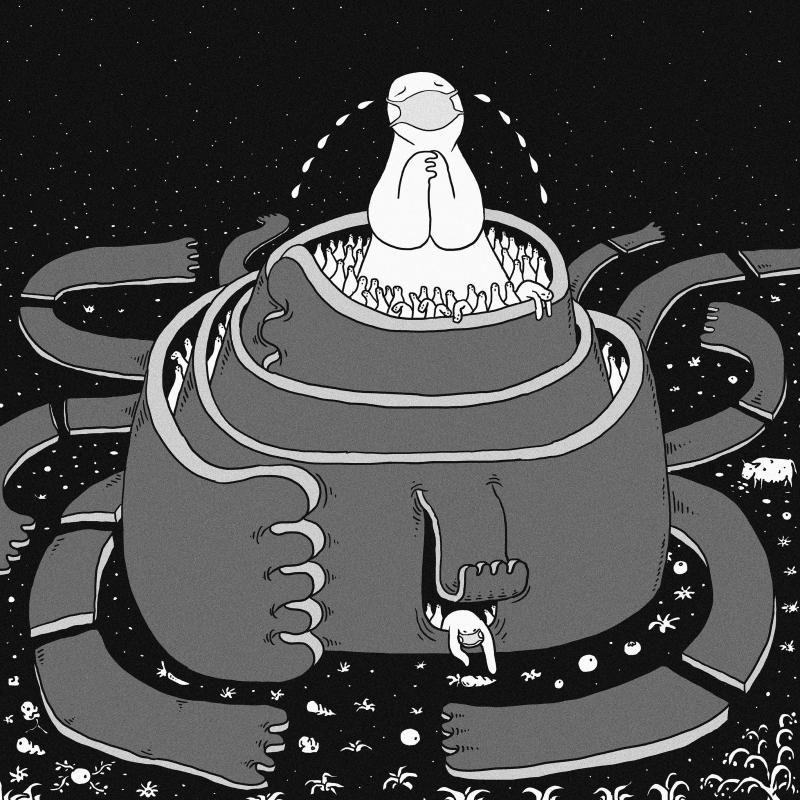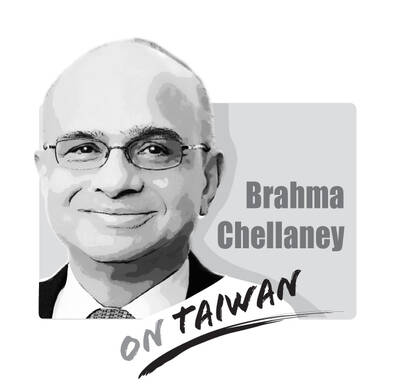In the fertile Satara District in western India, farmers are putting their cattle on an unorthodox diet: Some are feeding iceberg lettuce to buffalo, while others are feeding strawberries to cows.
It is not a treat. They can let their crops spoil or feed them to animals.
Other farmers are letting their crops spoil, dumping off truckloads of fresh grapes to rot on compost heaps.

Illustration: Mountain People
The farmers cannot get their produce to consumers because of lockdowns that aim to stop the spread of the COVID-19 pandemic.
In India, as in many parts of the world, restrictions on population movement are wreaking havoc on farming and food-supply chains, and raising concern of more widespread shortages and price spikes to come.
Across the globe, millions of laborers cannot get to the fields for harvesting and planting. There are too few truckers to keep goods moving. Air freight capacity for fresh produce has plummeted as airplanes are grounded. There is also a shortage of food containers for shipping, because of a drop in voyages from China.
In Florida, a lack of Mexican migrant laborers means that watermelon and blueberry growers face the prospect of rotting crops. Similar shortages of workers in Europe mean that vegetable farms are missing the window to plant.
Such sprawling food production and distribution shocks illustrate the pandemic’s seemingly boundless capacity to suffocate economies worldwide and upend even the most essential business and consumer markets.
There has been limited disruption so far to supplies of staple grains such as rice and wheat, although problems with planting and logistics are mounting.
In Satara District, Indian farmer Anil Salunkhe is feeding his strawberries to cows because the local tourists that usually eat them are gone, as are the fruit vendors that once worked the streets of nearby Mumbai.
“Nobody was willing to buy strawberries due to the lockdown,” he said.
Salunkhe said that he cannot even give his strawberries away, because with orders to stay home, few villagers would leave their homes when he offered them the berries for free.
In nearby Bhuinj village, Prabhakar Bhosale feeds lettuce to buffalo and lets villagers take more for their own cattle. The hotels and restaurants that normally buy lettuce are closed.
The potential effects of planting and harvest disruptions are most acute in poorer countries with big populations, UN Food and Agriculture Organization senior economist Abdolreza Abbassian said.
India — the world’s second-most populous country, where a majority of the population is involved in agriculture — is among the most vulnerable nations to the disruptions.
Indian Prime Minister Narendra Modi imposed a 21-day lockdown with just a few hours’ notice on March 25, leaving many of its 120 million migrant laborers struggling to get home and with no money for rent, food or transport.
LABOR SHORTAGES
The country’s northern grain bowl relies on labor from the eastern parts of the country, but workers have left the farms because of the lockdown.
“Who is going to fill the grain bags and bring the produce to market, and transport it to mills?” asked Jadish Lal, a merchant at Punjab’s Khanna Grain Market, the country’s largest.
Supply problems in one place are quickly felt on the other side of the world. In Canada, imports of specialty Indian vegetables such as onions, okra and eggplant have dropped by as much as 80 percent over the past two weeks as air cargo space dwindled, said Clay Castelino, president of Ontario-based Orbit Brokers, which helps shipments clear customs.
The sharp decline meant that the food must have simply gone to waste, Castelino said.
“With perishable food, once it’s gone, it’s gone,” he added.
Spain has a shortage of migrant workers from countries such as Morocco, because they cannot travel.
“In about 15 days’ time, the blueberry season will peak until mid-May,” said Francisco Sanchez, a manager at Spanish growers’ association Onubafruit. “We need a big concentration of labor then.”
In Italy, about 200,000 seasonal workers are needed over the next two months.
The government might need to ask people receiving state benefits to pick the fruit and vegetables, Italy’s Food Association Federalimentare head Ivano Vacondio said.
French Minister of Agriculture Didier Guillaume has issued a rallying cry to what he called France’s “shadow army” of newly laid-off workers to replace the usual crews of migrant workers on farms.
“If the call is not heard, the production will remain in the fields and the entire sector will be damaged,” said Christiane Lambert, head of France’s largest farm union, FNSEA.
In Brazil — the world’s top exporter of soybeans, coffee and sugar — farm lobby CNA said that the industry faces a range of problems, including challenges hiring truck drivers to haul crops and a shortage of spare parts for farm equipment.
In Argentina — the world’s top exporter of soymeal — exports have been delayed as the government ramps up inspections of incoming cargo ships.
A sharp decline in air traffic has also cut deeply into capacity to move fresh produce long distances.
Andres Ocampo, chief executive of HLB Specialties, a fruit importer based in Miami, Florida, relied on commercial flights to shift papayas and other produce from Brazil, but he has switched to buying more from Mexico and Guatemala, where goods can still be shipped by truck.
Volumes of the company’s imports from Brazil have dropped by 80 percent, Ocampo said.
“In Europe, it’s even worse, because they don’t have a Mexico-like source for papayas,” he added.
CONTAINER SHORTAGES
Exporters in the US and Canada are grappling with a shortage of refrigerated containers to supply goods, as voyages of container ships from China to the Pacific coast of North America are down by a quarter due to reduced demand because of lockdowns.
“The containers are tough to get right now,” said Michael Dykes, president of the International Dairy Foods Association, a US-based trade group. “If a company needs five containers, they’ll find they can get one.”
Port congestion is slowing shipments of pork and beef to destinations such as China, because workers have been told to stay at home. That is exacerbating the shortage of protein supplies in China, where an outbreak of African swine fever has taken a quarter of the world’s pigs off the market over the past two years.
The emerging supply-chain disruptions are much different than the food crises of 2007 to 2008 and 2010 to 2012, when droughts in grain-producing nations caused shortages that led to higher prices, unrest and riots in several countries. Those price spikes were driven in part by states hoarding rice and other staples.
Now, staple grain supplies are relatively plentiful and global prices have been low for years as farmers in the US, Brazil and in the Black Sea region have planted more and improved yields.
Although there are signs that big importers such as Iraq and Egypt are boosting grain purchases amid rising concern over food security, other countries are boosting exports.
For example, Thailand — the world’s second-largest rice exporter — is taking advantage of higher rice prices by increasing exports from stockpiles.
However, top rice exporter India has stopped rice exports due to labor shortages and logistics problems. Third-largest exporter Vietnam has also curbed exports.
African nations — where many people spend more than half of their income on food — are among the most vulnerable to disruptions in staple food supplies.
The continent is the fastest-growing consumer of rice, accounting for 35 percent of global imports and 30 percent of wheat imports. Sub-Saharan Africa alone is the third-largest rice consuming region, yet holds the smallest grain inventories — relative to demand — of all regions, because of tight government budgets and limited storage.
While prior food crises involved supply shocks, the problem today is getting plentiful supplies to the people who need it — many of whom have suddenly lost their income.
“It is a whole different animal,” Abbassian said. “You don’t have labor, you don’t have trucks to move the food and you don’t have money to buy the food.”
Additional reporting by Mayank Bhardwaj, Veronica Brown, Jonathan Saul, Sonya Dowsett, Libby George, Phil Blenkinsop, Stephen Jewkes, Gus Trompiz, Sybille de La Hamaide, Emma Farge, Michael Hogan, Christopher Walljasper, Karl Plume, P.J. Huffstutter, Tom Polansek, Rod Nickel and Ana Mano
Recently, China launched another diplomatic offensive against Taiwan, improperly linking its “one China principle” with UN General Assembly Resolution 2758 to constrain Taiwan’s diplomatic space. After Taiwan’s presidential election on Jan. 13, China persuaded Nauru to sever diplomatic ties with Taiwan. Nauru cited Resolution 2758 in its declaration of the diplomatic break. Subsequently, during the WHO Executive Board meeting that month, Beijing rallied countries including Venezuela, Zimbabwe, Belarus, Egypt, Nicaragua, Sri Lanka, Laos, Russia, Syria and Pakistan to reiterate the “one China principle” in their statements, and assert that “Resolution 2758 has settled the status of Taiwan” to hinder Taiwan’s
Singaporean Prime Minister Lee Hsien Loong’s (李顯龍) decision to step down after 19 years and hand power to his deputy, Lawrence Wong (黃循財), on May 15 was expected — though, perhaps, not so soon. Most political analysts had been eyeing an end-of-year handover, to ensure more time for Wong to study and shadow the role, ahead of general elections that must be called by November next year. Wong — who is currently both deputy prime minister and minister of finance — would need a combination of fresh ideas, wisdom and experience as he writes the nation’s next chapter. The world that

Can US dialogue and cooperation with the communist dictatorship in Beijing help avert a Taiwan Strait crisis? Or is US President Joe Biden playing into Chinese President Xi Jinping’s (習近平) hands? With America preoccupied with the wars in Europe and the Middle East, Biden is seeking better relations with Xi’s regime. The goal is to responsibly manage US-China competition and prevent unintended conflict, thereby hoping to create greater space for the two countries to work together in areas where their interests align. The existing wars have already stretched US military resources thin, and the last thing Biden wants is yet another war.
Since the Russian invasion of Ukraine in February 2022, people have been asking if Taiwan is the next Ukraine. At a G7 meeting of national leaders in January, Japanese Prime Minister Fumio Kishida warned that Taiwan “could be the next Ukraine” if Chinese aggression is not checked. NATO Secretary-General Jens Stoltenberg has said that if Russia is not defeated, then “today, it’s Ukraine, tomorrow it can be Taiwan.” China does not like this rhetoric. Its diplomats ask people to stop saying “Ukraine today, Taiwan tomorrow.” However, the rhetoric and stated ambition of Chinese President Xi Jinping (習近平) on Taiwan shows strong parallels with